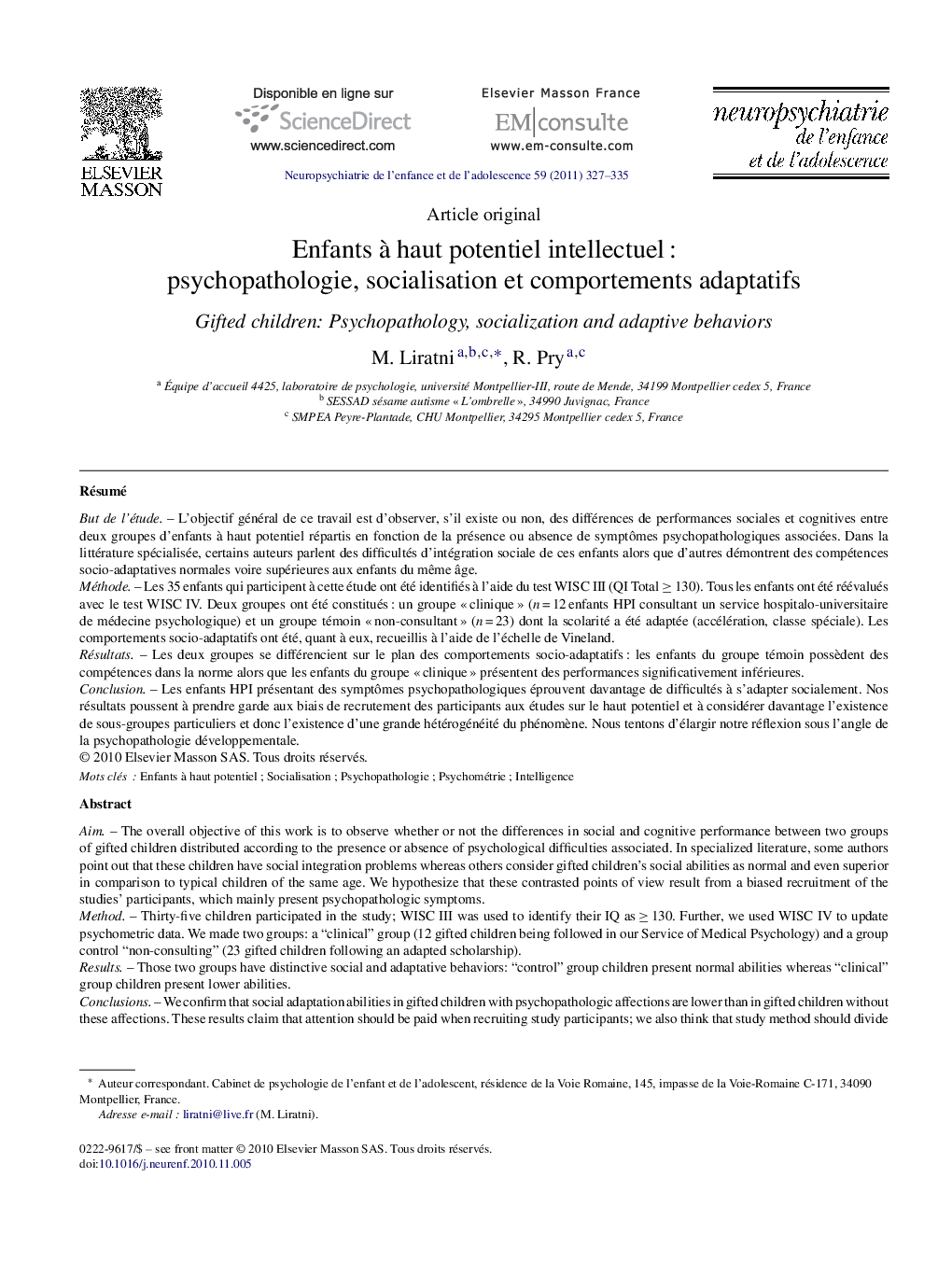| کد مقاله | کد نشریه | سال انتشار | مقاله انگلیسی | نسخه تمام متن |
|---|---|---|---|---|
| 944138 | 925582 | 2011 | 9 صفحه PDF | دانلود رایگان |

RésuméBut de l’étudeL’objectif général de ce travail est d’observer, s’il existe ou non, des différences de performances sociales et cognitives entre deux groupes d’enfants à haut potentiel répartis en fonction de la présence ou absence de symptômes psychopathologiques associées. Dans la littérature spécialisée, certains auteurs parlent des difficultés d’intégration sociale de ces enfants alors que d’autres démontrent des compétences socio-adaptatives normales voire supérieures aux enfants du même âge.MéthodeLes 35 enfants qui participent à cette étude ont été identifiés à l’aide du test WISC III (QI Total ≥ 130). Tous les enfants ont été réévalués avec le test WISC IV. Deux groupes ont été constitués : un groupe « clinique » (n = 12 enfants HPI consultant un service hospitalo-universitaire de médecine psychologique) et un groupe témoin « non-consultant » (n = 23) dont la scolarité a été adaptée (accélération, classe spéciale). Les comportements socio-adaptatifs ont été, quant à eux, recueillis à l’aide de l’échelle de Vineland.RésultatsLes deux groupes se différencient sur le plan des comportements socio-adaptatifs : les enfants du groupe témoin possèdent des compétences dans la norme alors que les enfants du groupe « clinique » présentent des performances significativement inférieures.ConclusionLes enfants HPI présentant des symptômes psychopathologiques éprouvent davantage de difficultés à s’adapter socialement. Nos résultats poussent à prendre garde aux biais de recrutement des participants aux études sur le haut potentiel et à considérer davantage l’existence de sous-groupes particuliers et donc l’existence d’une grande hétérogénéité du phénomène. Nous tentons d’élargir notre réflexion sous l’angle de la psychopathologie développementale.
AimThe overall objective of this work is to observe whether or not the differences in social and cognitive performance between two groups of gifted children distributed according to the presence or absence of psychological difficulties associated. In specialized literature, some authors point out that these children have social integration problems whereas others consider gifted children's social abilities as normal and even superior in comparison to typical children of the same age. We hypothesize that these contrasted points of view result from a biased recruitment of the studies’ participants, which mainly present psychopathologic symptoms.MethodThirty-five children participated in the study; WISC III was used to identify their IQ as ≥ 130. Further, we used WISC IV to update psychometric data. We made two groups: a “clinical” group (12 gifted children being followed in our Service of Medical Psychology) and a group control “non-consulting” (23 gifted children following an adapted scholarship).ResultsThose two groups have distinctive social and adaptative behaviors: “control” group children present normal abilities whereas “clinical” group children present lower abilities.ConclusionsWe confirm that social adaptation abilities in gifted children with psychopathologic affections are lower than in gifted children without these affections. These results claim that attention should be paid when recruiting study participants; we also think that study method should divide participants in subgroups, considering that giftedness presents a certain degree of heterogeneity. We try to out light the observed difficulties in “clinical” gifted children referencing to developmental psychopathology.
Journal: Neuropsychiatrie de l'Enfance et de l'Adolescence - Volume 59, Issue 6, October 2011, Pages 327–335